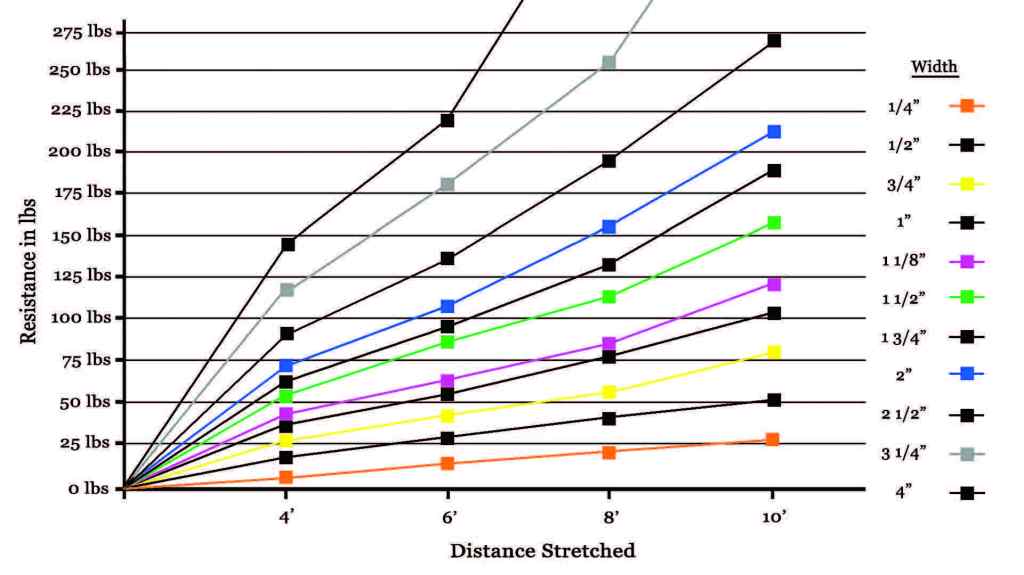Patrick Gilbert PT, DPT, ATC, CSCS
Resistance bands have continued to gain popularity in the fitness industry in recent years. The reality is if you aren’t using bands in your training, you may be leaving something on the table. Here are some of the best reasons and most important ways to utilize resistance bands to help optimize your training.
Convenience and Versatility
To start, training with resistance bands is extremely convenient. This is especially true if you train in a small space, don’t have access to other weight equipment or travel frequently. Compared with other traditional strength training equipment, bands pack up very easily. They are also light and compact. You can’t exactly pack a 45lb barbell between 5 and 6 feet long into a suitcase or a duffel bag! With bands, you can pack and unpack your equipment in seconds, making it a quick and easy way to add banded resistance to a training session virtually anywhere.
Bands are also incredibly versatile. They can be used for essentially any exercise you could do with dumbbells, barbells or other heavy, expensive equipment. As long as you have something stable to tie or anchor the band, you can use resistance bands almost anywhere. Here is a quick guide on How to Anchor Resistance Bands.
The other great thing about using resistance bands in your training is that you are only limited by your creativity. If you can find a way to substitute a band for another piece of equipment or to modify an existing exercise, your workout options become nearly limitless. By making small changes to the direction of pull or your grip, you can find the sweet spot and nail all of your band exercises.
Graded Resistance and Constant Tension
The variable resistance bands offer also demonstrate their versatility. The resistance any given band provides depends almost entirely on the amount of tension placed on that band. The more tension in the band, the more resistance it provides. The same band can have anywhere from light to heavy resistance, just based on how far you stretch the band. This resistance changes depending on how far you stretch the band from its anchor or how far apart you hold the band in your hands. This makes bands a perfect tool for making subtle tweaks to your workouts when an exercise is too difficult or too easy. Check out this graphic from Perform Better, demonstrating the graded resistance that their Superbands offer based on the width of the band and how far that band is stretched. They also sell Minibands, which can be used for a number of exercises as well.
Not only do bands provide variable resistance, but they also offer constant resistance (as long as there is some level of tension in the band). Unlike the weight stack on your favorite lat pulldown machine, a resistance band will never be “weightless” at the top of a movement, no matter how hard you push or pull.
Corrective Exercises
One of the main ways people think to utilize resistance bands or minibands is for corrective exercises. If you’ve ever been around a rehabilitation clinic, I’m sure you’ve seen minibands used for clamshells and either superbands or a red or green Theraband used for band pull-aparts or rows. While I could go into an entire article about corrective exercises and their overprescription, they are an integral part of a good training program if they are addressing a specific movement or soft tissue impairment. Nobody ever got strong as heck doing correctives all day, but there is certainly a time and a place for them. I have specific correctives that I program into my warm-up routines to address common problem areas, whether they manifest as a mobility deficit or a lack of strength in a specific area. No matter what, there should always be a “why” behind corrective exercises.
There should always be a “why” behind corrective exercises
Tweet
One of my favorite lower body corrective exercises that I use a superband for is to improve ankle dorsiflexion. The Half-Kneeling Band-Assisted Dorsiflexion Mobilization with Movement (kind of a mouthful if you ask me, but it gets the point across) is a great way to functionally improve dorsiflexion while utilizing a superband to provide an external load to the mobilization.
The goal is to situate the band on your talus (below the crease in your ankle) and keep it there with one hand. Keep your heel locked in place with your other hand. It is always important to be specific with your mobilizations and stretches. From there, lean your shin forward and hold for anywhere from 5-10 seconds. Rinse and repeat for a handful of reps.
Building Strength and Endurance in Accessory Muscles
Resistance bands can also be used for exercises that target “accessory muscles”. These are generally muscles that play a vital role in joint and posture health, but aren’t the coveted “glory muscles”. Plenty of people will notice big quads, pecs and calves, but how many people have been complimented on their posterior deltoid or their gluteus medius? One of the ways I commonly use bands for correctives is to target accessory or stabilizing muscles at big joints. These are often the shoulder or hip, but can also address other joints and areas of the body too, like the ankle, knees or spine.
I love to use minibands to help with lateral hip strength, endurance and stability. Aside from lateral band walks, which everybody and their cousin know about, I also use them for ”sailor walks” (also affectionately known as “penguin walks”). Check out the video and you’ll have a better idea of how they got their name.
The goal here is to keep your hips level and extended as you rock from side to side. The great thing here is that both glutes will be working the whole time. One will be forced to stabilize the pelvis while the other is tasked with maintaining tension on the band. Hold for 3-5 seconds on one side, then keep the same stance width while switching to the other side. Burn baby, burn!
Another fantastic exercise for shoulder durability is one that Dr. John Rusin has popularized in recent years: the band face pull. At face value, this exercise does a great job at building strength and endurance in your posterior shoulders. As an added bonus, it also encourages extension through the upper thoracic spine, resulting in improved, upright posture. The other great thing about this exercise aside from building brutally strong shoulders is that it is extremely joint-friendly. You can crank out reps by the dozens and get a massive muscle pump without sacrificing your joints in the process.
To perform this exercise, tie a band around a sturdy post or anchor it inside of a door just above head height. Hold the band with about 1-2 fist-widths between your hands. Maintain a stable stance with a slight knee bend and your core engaged. Pull the band back toward your face while simultaneously pulling your hands apart. Think about squeezing the back of your shoulders and bringing your shoulder blades together and holding for a brief moment before slowly controlling the band back to its starting position.
Adding Band Resistance to Create Power
In addition to utilizing resistance bands to replace weightlifting equipment, they can also be used in conjunction with traditional strength training. They can be an awesome addition to barbell or dumbbell lifts by either adding complexity and resistance or assisting you to perform a movement by decreasing resistance. The outcome depends entirely on how you set them up.
By adding banded resistance to an exercise, such as the bench press in the video below, you are increasing the load towards the end of the movement (as the barbell pulls the bands tighter). This forces the body to recruit additional muscle fibers to continue the movement and can help to develop power. Moving the bar with speed and intent is key here, as you will have to move through progressive resistance as tension increases in the bands. There will also be more resistance during the eccentric lowering portion of the movement, as the band is pulling down against you. Because of the increased demand during the eccentric phase, you will build muscle and strength even faster than with traditional strength training. It is possible to notice yourself becoming more sore after training with added band resistance, but that is a small price to pay for improved strength and power!
With this said, you will generally have to use a bit less weight on the bar than without bands, as the bands provide extra load to the bar. By beginning with less load while the bands are on relative slack at the bottom of the movement (when muscles and joints are generally at a mechanical disadvantage relative to the stronger mid-portion of the movement) you can initiate and continue to move the bar with more speed. More speed, especially once the extra tension kicks in as the bands are stretched, leads to more power!
Band-Assisted Exercises to Improve Strength
Bands can also be used to lighten the load in certain positions of a movement. Take this band-assisted squat below, for example. By hanging bands from the top of a rack and attaching them to the barbell, they will provide the most assistance as you near the bottom of the movement. As the tension lessens as you come back up, the bands will provide less assistance and you are forced to do more on your own.
This technique is especially helpful if you struggle at the bottom of an exercise. Again, this plays into the length-tension relationship and helps the body move a heavy load while the muscles are mechanically disadvantaged in a lengthened position. Band assistance can be the extra push you need to get up out of the hole at the bottom of your squat and crush new PRs. While utilizing bands to increase load will require you to use sub-maximal loads, this band-assisted technique should allow you to use supra-maximal loads and move some serious weight!
The other difference band-assisted exercises have compared to using bands to increase load is that the bands will help to lighten the load more as you move toward the bottom of the exercise. Instead of increasing the speed during the eccentric portion of a movement, this technique will actually help you to decelerate the barbell as you lower it towards the bottom of a movement. This results in a more joint-friendly method to lift, especially as you load up these movements.
While both of these techniques have similarities (less load at the beginning of a movement, more load towards the end), the difference in where the band is offering resistance or assistance plays a major role in deciding which one will be used depending on your goal for the exercise. If improving power is your goal, you will likely want to go with banded resistance and take some weight off the bar. If you want to improve strength, the band-assisted technique is probably your best bet.
…
Bands are convenient, versatile and can be used in ways that dumbbells and barbells simply can’t. They can provide a fresh stimulus to help with your strength and power as well as hammering the basics of correctives and accessory muscles.
If you want to dive completely into training with resistance bands, check out my 6-week program, Work(out) From Home. This program contains everything you need to complete workouts that are targeted to hit each fundamental movement pattern, plus functional cardio and recovery.
My goal here was to demonstrate that resistance bands can offer so much more than simple corrective exercises. Yes, bands can be used if you are limited by the current equipment or space at your disposal. However, they can also be an important addition to traditional strength training. Training with resistance bands can offer a nice change of pace and are extremely effective for all the reasons I’ve outlined here.
About the Author – Patrick Gilbert PT, DPT, ATC, CSCS

Patrick is a physical therapist, athletic trainer and personal trainer. He runs Summit Performance and Therapy in Indianapolis, Indiana. He has been training clients of all backgrounds for years and has been a practicing physical therapist since 2016. His training philosophy combines his knowledge of rehabilitation as well as strength and conditioning in order to train clients to achieve great results and avoid injuries in the process. His physical therapy practice focuses on a three-dimensional view and treatment of the body and its many parts. Treatment emphasizes manual techniques and rehabilitative exercises to get patients back to previous activity levels without pain or dysfunction.
For more information about training or rehabilitating with Patrick, contact him at SummitPerformancePT@gmail.com or visit SummitPerformancePT.com



1 thought on “How to Utilize Resistance Bands in Your Training”